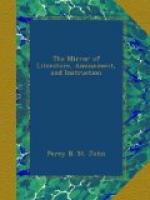P.T.W.
* * * * *
THE NATURALIST.
* * * * *
BEES.
The faculty, or instinct of bees is sometimes at fault, for we often hear of their adopting the strangest and most unsuitable tenements for the construction of cells. A hussar’s cap, so suspended from a moderate sized branch of a tree, as to be agitated by slight winds, was found filled with bees and comb. An old coat, that had been thrown over the decayed trunk of a tree and forgotten, was filled with comb and bees. Any thing, in short, either near the habitations of man, or in the forests, will serve the bees for a shelter to their combs.
The average number of a hive, or swarm, is from fifteen to twenty thousand bees. Nineteen thousand four hundred and ninety-nine are neuters or working bees, five hundred are drones, and the remaining one is the queen or mother! Every living thing, from man down to an ephemeral insect, pursues the bee to its destruction for the sake of the honey that is deposited in its cell, or secreted in its honey-bag. To obtain that which the bee is carrying to its hive, numerous birds and insects are on the watch, and an incredible number of bees fall victims, in consequence, to their enemies. Independently of this, there are the changes in the weather, such as high winds, sudden showers, hot sunshine; and then there is the liability to fall into rivers, besides a hundred other dangers to which bees are exposed.
When a queen bee ceases to animate the hive, the bees are conscious of her loss; after searching for her through the hive, for a day or more, they examine the royal cells, which are of a peculiar construction and reversed in position, hanging vertically, with the mouth underneath. If no eggs or larvae are to be found in these cells, they then enlarge several of those cells, which are appropriated to the eggs of neuters, and in which queen eggs have been deposited. They soon attach a royal cell to the enlarged surface, and the queen bee, enabled now to grow, protrudes itself by degrees into the royal cell, and comes out perfectly formed, to the great pleasure of the bees.
The bee seeks only its own gratification in procuring honey and in regulating its household, and as, according to the old proverb, what is one man’s meat is another’s poison, it sometimes carries honey to its cell, which is prejudicial to us. Dr. Barton in the fifth volume, of the “American Philosophical Transactions,” speaks of several plants that yield a poisonous syrup, of which the bees partake without injury, but which has been fatal to man. He has enumerated some of these plants, which ought to be destroyed wherever they are seen, namely, dwarf-laurel, great laurel, kalmia latifolia, broad-leaved moorwort, Pennsylvania mountain-laurel, wild honeysuckle (the bees, cannot get much of this,) and the stramonium or Jamestown-weed.




